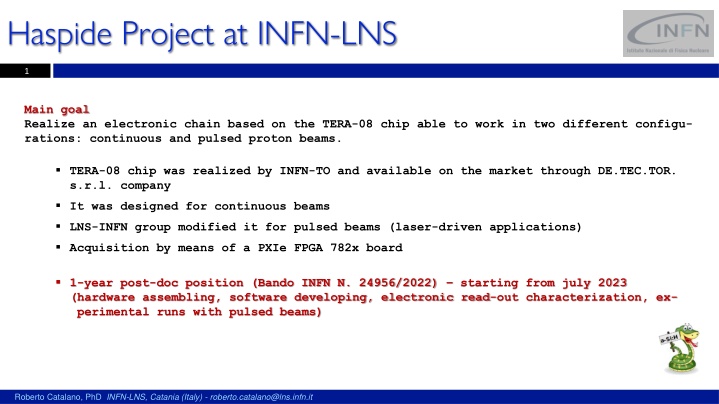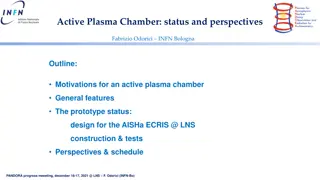
Electronic Chain Based on TERA-08 Chip for Pulsed Proton Beams
Join the Haspide Project at INFN-LNS to develop an electronic chain utilizing the TERA-08 chip for both continuous and pulsed proton beams. This project involves hardware assembly, software optimization, read-out characterization, and detector testing with pulsed beams accelerated by laser-matter interaction. Collaborate with experts like Roberto Catalano for a cutting-edge scientific endeavor.
Download Presentation

Please find below an Image/Link to download the presentation.
The content on the website is provided AS IS for your information and personal use only. It may not be sold, licensed, or shared on other websites without obtaining consent from the author. If you encounter any issues during the download, it is possible that the publisher has removed the file from their server.
You are allowed to download the files provided on this website for personal or commercial use, subject to the condition that they are used lawfully. All files are the property of their respective owners.
The content on the website is provided AS IS for your information and personal use only. It may not be sold, licensed, or shared on other websites without obtaining consent from the author.
E N D
Presentation Transcript
Haspide Project at INFN-LNS 1 Main goal Realize an electronic chain based on the TERA-08 chip able to work in two different configu- rations: continuous and pulsed proton beams. TERA-08 chip was realized by INFN-TO and available on the market through DE.TEC.TOR. s.r.l. company It was designed for continuous beams LNS-INFN group modified it for pulsed beams (laser-driven applications) Acquisition by means of a PXIe FPGA 782x board 1-year post-doc position (Bando INFN N. 24956/2022) starting from july 2023 (hardware assembling, software developing, electronic read-out characterization, ex- perimental runs with pulsed beams) Roberto Catalano, PhD INFN-LNS, Catania (Italy) - roberto.catalano@lns.infn.it
Electronic chain for pulsed beams 6 NI PXIe-1071 chassis NI PXIe-7821R Digital I/O Thanks to: Antonino Amato (INFN-LNS) The (Kintex-7 160T type, National Instruments) Digital I/O module include a FPGA We will use LabView to configure the FPGA and thus set the characteristics of the acquisition system (as the externally settable parameters of TERA08). In addition, LabView enables on- line data processing, resulting in a significant spare of time. Roberto Catalano, PhD INFN-LNS, Catania (Italy) - roberto.catalano@lns.infn.it
Electronic chain for pulsed beams 6 SETUP CONFIGURATION FOR ACQUISITION WITH NI PXI CRATE AND PXIe FPGA 782x BOARD NI PXIe-1071 chassis NI PXIe-7821R Digital I/O The (Kintex-7 160T type, National Instruments) Digital I/O module include a FPGA We will use an electronic board to connect the chassis input/output modules to the TERA08. The board was specifically designed by DE.TEC.TOR. s.r.l. to allow the connection between the two devices, which have different binning characteristics. Roberto Catalano, PhD INFN-LNS, Catania (Italy) - roberto.catalano@lns.infn.it
Haspide Project at INFN-LNS: next steps 7 Hardware assembling - july 2023 Realization and optimization of the software control system september 2023 Read-out characterization (background current, linearity of current-to-frequency con- version, charge conversion efficiency, gain october 2023 uniformity, channel cross-talking) Detector tests and characterization with pulsed proton beams accelerated by laser- matter interaction at ELI-Beamlines (Prague, Czech Republic) from november 2023 Roberto Catalano, PhD INFN-LNS, Catania (Italy) - roberto.catalano@lns.infn.it

